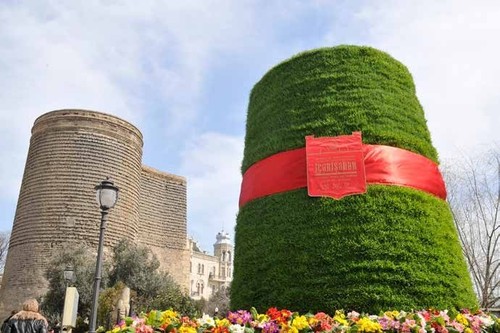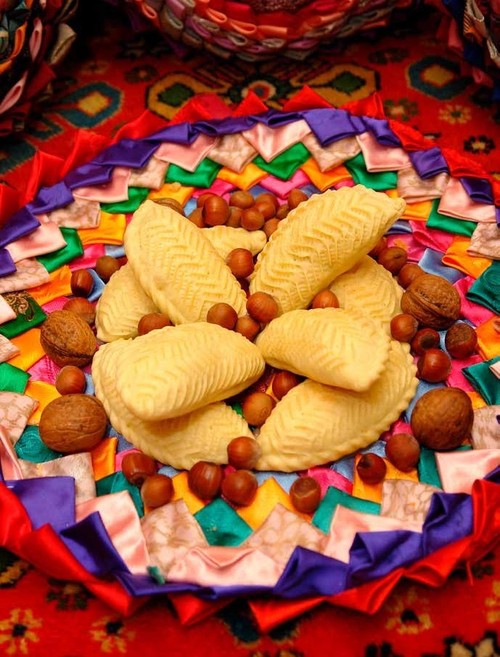 The symbol of the Novruz festival represents the triumph of, winning against the evil forces of darkness that are represented by the winter. (Photo credit: Azerbaijan Embassy in Vietnam) The symbol of the Novruz festival represents the triumph of, winning against the evil forces of darkness that are represented by the winter. (Photo credit: Azerbaijan Embassy in Vietnam)
|
What is Novruz and when is it celebrated?
Novruz is a 3,000-year-old celebration that heralds the arrival of spring and is seen as the start of a New Year. Novruz literally means "New Day". The festival is observed on the vernal equinox, which occurs on either March 20 or 21, when the length of day and night is equal. It also marks the start of spring.
In 2009 this amazing holiday was registered on the list of the Intangible Cultural Heritage of Humanity by the United Nations Educational, Scientific, and Cultural Organization (UNESCO) as the New Year celebrated by several countries, including Azerbaijan, Iran, Pakistan, Turkey, and Kazakhstan.
What is the symbol of Novruz?
One of the main symbols of Novruz is samani - green sprouting wheat. The growing of samani is an important Novruz ceremony as the herald of spring. Sprouting samani symbolizes sowing and a rich harvest. It represents grain, bread, increase, and abundance. Grain and abundance are a pledge of life, existence, the most vital material necessity for life. People have always grown samani from wheat, barley, peas, lentils or other grains in copper dishes. They have always revered it and rejoiced at its sprouting.
Khoncha is one of the essential parts of the holiday table. It is a tray filled with sweets, nuts, candies, and other treats. Each of the sweets baked for Novruz has a symbolic meaning. Pakhlava represents the four parts of the world, Goghal – the sun, Shekerbura – the moon, and the eggs painted for Novruz are a symbol of life. Samani decorates the middle of the tray and is tied with red ribbon.
What are main festivities during the Novruz holiday?
As a long-awaited event, Novruz is celebrated for a full month leading up to the holiday, very much like a festival. Tuesdays in the lead-in weeks celebrate different elements:
Water: Renewal
Fire: Rebirth
Earth: Revival
Wind: Opening of spring elements
Activities during the festival are familiar springtime activities such as cleaning the house, planting trees, and painting eggs.
On the day before Novruz’s official date Azerbaijani families visit the graves of their relatives. Then in the evening the whole family eats at least seven different dishes together around a table traditionally decorated with a copper plate and a painted egg. A mirror and candles should also be on the table. The candle is a symbol of fire and light (keeping a person from harm). The mirror is a symbol of happiness.
A bonfire is built when it becomes dark. People gather, joke, laugh, have fun, and dance, and when the fire gets smaller, they jump over it saying “let all my pains and sorrows be gone with the fire”, thus leaving all their problems behind with the past year. This is how the New Year begins.
In the evening, children put hats under their neighbors’ doors, then hide and wait for the neighbors to fill the hats with holiday treats.
 Azerbaijan national pastry shakarbura (Photo credit: Azerbaijan Embassy in Vietnam) Azerbaijan national pastry shakarbura (Photo credit: Azerbaijan Embassy in Vietnam)
|
What kinds of food do Azerbaijanis have or make for the special event?
A special table is prepared with specific foods that are must-have for Novruz. Azerbaijanis put at leastseven foods that begin with the letter "s" on the holiday table to symbolize the traditions of Novruz: su (water), süd (milk), səməni (green spouting wheat), səbzə (fresh greens), sumaq (sour spice), sümbül (wheat-ear), and others. This is associated with the belief that success will be brought by the number 7, which is considered sacred. Traces of mysticism can also be found in pastries that are peculiar to Novruz, namely the shekerbura, goghal, and pakhlava. Each of these sweets bears a symbolic meaning pertaining to the sky, the sun, the moon and the stars.
Round toasted crispy orange-yellow goghal depicts the sun, while the half-circle-shaped shekerbura and its decorative surface patterns represent a half-moon. The diamond shape of pakhlava with four angles is said to portray the four corners of the world. In other versions, the seven-fold thin dough of pakhlava cut into diamond shapes with a hazelnut kernel atop the center represents the sky and stars, respectively.
The main traditional dish on Novruz is Shah Plov or "Crown Plov", known as the king of dishes. It’s considered to be the most special dish in Azerbaijani cuisine. The addition of saffron makes the Azerbaijani rice unique. But what makes the Azerbaijani rice even more unique is the fact that the rice and other ingredients such as meat, dried fruits, chestnuts and etc. are being prepared separately and not together in one stew. Azerbaijani pilaf is flavored with a mixture of saffron, cloves, cinnamon, cilantro and ground peppers. Another traditional dish - dolma...It is grape or quince leaves filled with lamb or beef meat. Stuffed fish, also called "Balıq Ləvəngisi", is usually prepared for Novruz.The ingredients for stuffing include peeled walnuts, chopped and well-fried onions, sour prune or sour cherry or a pomegranate juice syrup called narsharab ("nar" is the local name of pomegranate in Azerbaijan), dried cherry-plums, raisins and vegetable oil. Certainly, these outstanding dishes cannot be missed on the table during festive evenings, weddings, and birthdays.
How about Novruz celebration in Vietnam?
There are a lot of similarities between Tet and Novruz holidays. Both of these holidays embody the arrival of the new year, the awakening of nature after winter, are an ancient and family holiday with common traditions, such as honoring the memory of the deceased, cooking special dishes and sweets. It is time for family union, when can gather with our relatives and gather with friends. In Vietnam most traditions associated with the festival are observed.The Azerbaijan Embassy organizes several activities to introduce Novruz to Vietnamese friends.